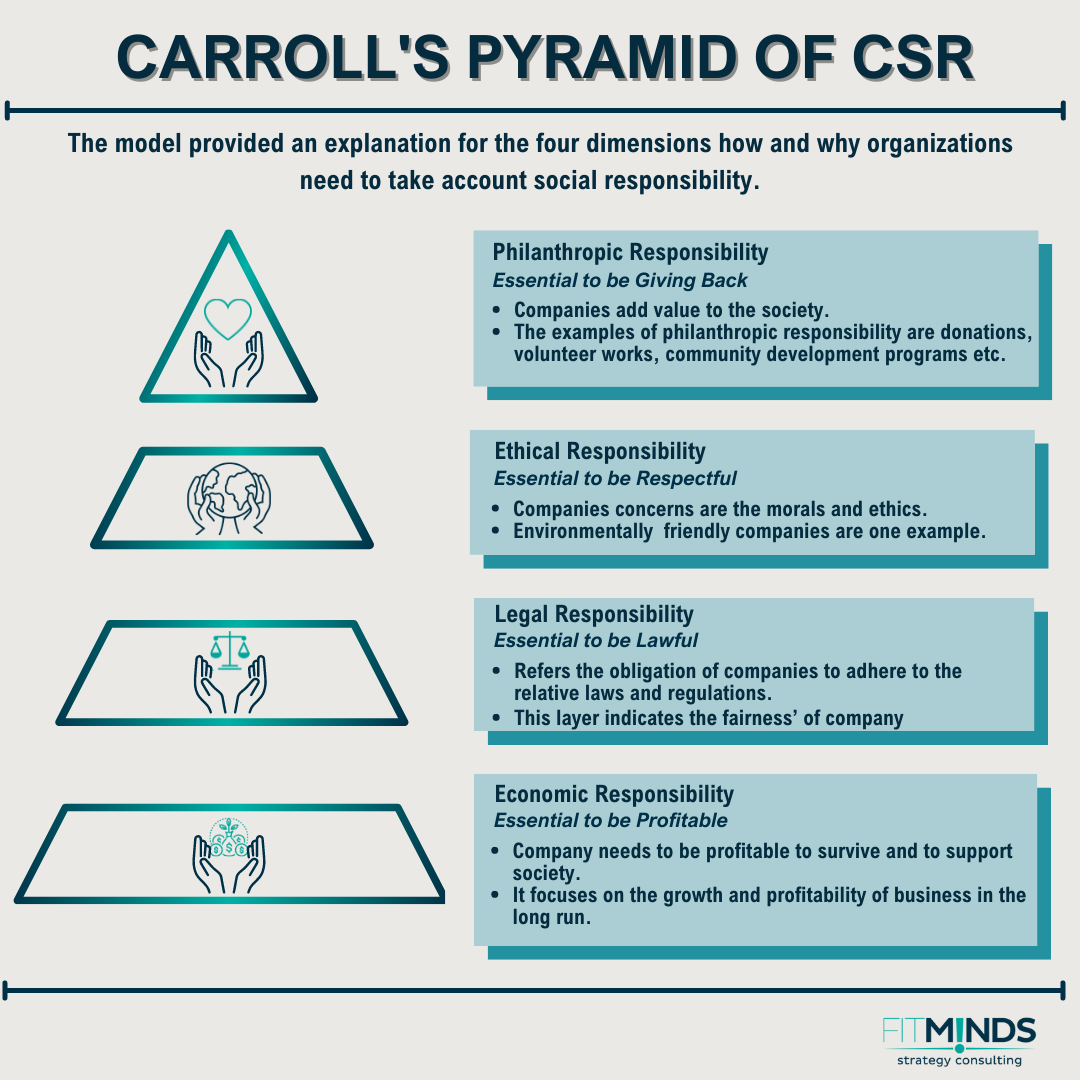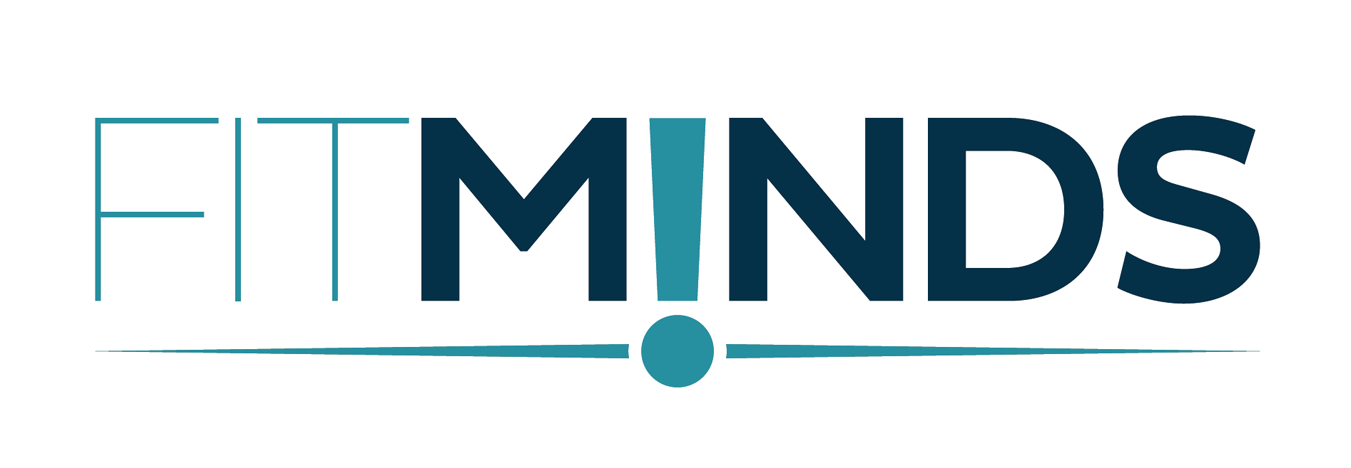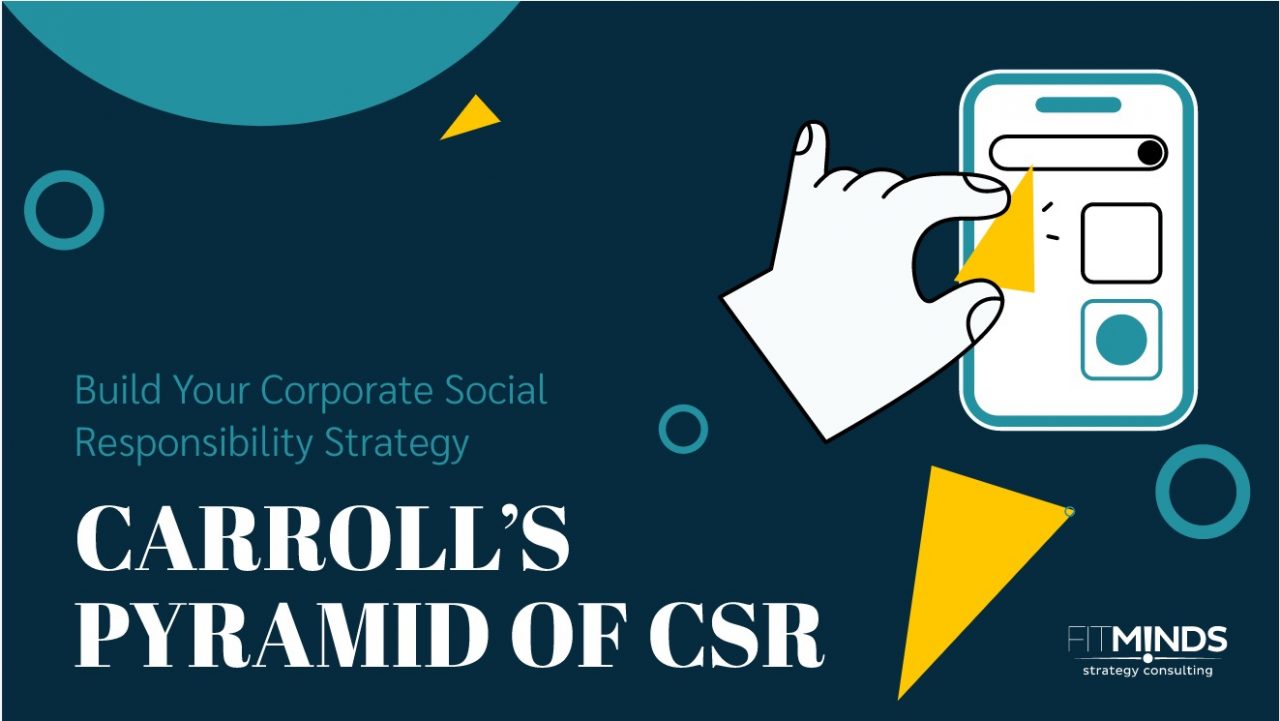Archie B. Carroll’s Corporation Social Responsibility (CSR) Pyramid Model was published in 1991 and became a well-known example in the CSR literature. The model provided an explanation for the four dimensions of how and why organizations need to take into account social responsibility.
The dimensions of Carroll’s CSR Pyramid Model:
There are four dimensions in the CSR Pyramid Model. If we list them from bottom to up, we will examine respectively:
- Economic Responsibility
- Legal Responsibility
- Ethical Responsibility
- Philanthropic Responsibility
Carroll’s CSR Pyramid Model helps you:
The CSR Pyramid Model has two major impacts on businesses. First, it assists in rising the social accountability of companies as an internal regulation of themselves. Being socially accountable has a positive impact on the company’s reputation among stakeholders and society. Secondly, Carroll’s CSR Pyramid helps to increase the competitive advantage of the companies. With the rising awareness of the company and its reputation, the pyramid can help to increase the loyalty of customers and shareholders, develop trust, rise sales, grow profits, and improve productivity.

Explanation of Carroll’s CSR Pyramid Model
- Economic Responsibility
Essential to be Profitable
Carroll’s CSR Pyramid model was established over the economic responsibility stage. The reason behind it can be rationalized as in the long run, a company needs to be profitable to survive in the industry and to support society. In this sense, the economic responsibility stage of the pyramid focuses solely on the growth and profitability of the business in the long run.
- Legal Responsibility
Essential to be Lawful
After the economic responsibility stage, the next layer in the CSR Pyramid is a legal responsibility. In the broad definition, legal responsibility refers to the obligation of companies to adhere to the relative laws and regulations. This layer indicates the company’s fairness on each level of the organization such as local, national, and regional levels.
- Ethical Responsibility
Essential to be Respectful
The ethical responsibility stage of the pyramid concerns morals and ethics, rather than being lawful. In this stage, companies need to monitor and respect moral standards and meet society’s expectations. Environmentally and ecologically friendly companies are one example of ethical responsibility.
- Philanthropic Responsibility
Essential to be Giving Back
The highest layer of Carroll’s CSR Pyramid is philanthropic responsibility. At that level, companies add value to society. More than doing the right thing, companies are giving back to the communities to make the world a better place. Examples of philanthropic responsibility are donations, volunteer work, community development programs, etc.
How to Apply Carroll’s CSR Pyramid Principle?
Engaging all layers of the pyramid. It is essential to examine the pyramid as a whole. Each layer ensures the previous layer is settled in the company. For instance, a company could not work on legal responsibility without ensuring that economic responsibility is sustainable. To ensure long-term profitability, use VRIO Framework and McKinsey’s Three Horizons of Growth.
Take into account all of your stakeholders. It is important to keep in mind that Carroll’s CSR Pyramid should cover all of your stakeholders in the supply chain. For example, the ethical responsibility of a company majorly focuses on respect for the moral standards of both the company and all suppliers of the company. You can look at CEAN, A Model by FITMINDS Strategy Consulting to design communication strategy during and after COVID-19.
Managing Effectively CSR Pyramid. To imply Carroll’s CSR Pyramid into your company successfully, you can create a management team for its initiatives and sustainability. Use Hambrick and Frederickson’s Strategy Diamond to fit CSR Pyramid into every part of your organization’s strategy.
Additional Tips and Readings
- VRIO Framework determines where your competitive advantage lies and how to exploit it.
- McKinsey’s Three Horizons of Growth to explore new paths to grow your business.
- CEAN, A Model by FITMINDS Strategy Consulting to design communication strategy during and after COVID-19.
- Hambrick and Frederickson’s Strategy Diamond to fit every part of your organization’s strategy.
Contact us to build your corporate social responsibility strategy to increase your company’s social accountability.



13 comments
Pingback: sans ordonnance kamagra pharmacie au rabais nouveau brunswick
Pingback: how to order enclomiphene purchase generic
Pingback: discount androxal generic switzerland
Pingback: ordering dutasteride where to purchase
Pingback: generique flexeril cyclobenzaprine
Pingback: get gabapentin france where to buy
Pingback: how to order fildena purchase online uk
Pingback: itraconazole overnight fedex
Pingback: online order avodart generic does it works
Pingback: buy cheap staxyn australia online no prescription
Pingback: get xifaxan buy japan
Pingback: rifaximin 50 mg low cost
Pingback: kamagra bez lékařského předpisu doručení následující den
Comments are closed.